When it comes to protecting the estate, the board is most often moved to the last plane. This material is considered by many to be a temporary and non-creative option.
However, in recent years, the design of board fences has changed significantly. From the primitive "ladders" they turned into masterpieces of wooden architecture. Excellent appearance, ease of installation and minimal cost attract the attention of many owners of suburban housing.
In this article we offer you an overview of modern fences from the board and practical recommendations for their manufacture. We hope that after getting acquainted with the presented options you will change your opinion and build a beautiful and practical board board fence in the dacha with your own hands.
Variants of board fences
In order to install a wooden fence you do not need to strain your imagination and test your design talents. Dozens of interesting varieties of fences have already been built and captured in the photo.
The simplest version is a horizontal fence made from a slab. Its cost is minimal, and the aesthetic qualities are high. Before installation, the croaker should be ennobled with grinding, toned with roasting and varnished. Otherwise, its external will cause association with the pasture for cattle.
Another tip. A wooden fence made from an unedged board looks ideal with wooden buildings. In the photo below, the white color of the walls of the mansion and the columns of the entrance group do not match well with the wooden fence.
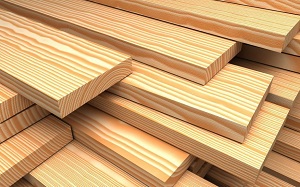
Fence from the croaker is simple, inexpensive and aesthetically pleasing
In this design, runs from the boards are fixed between two wooden posts. From the rain, the ends of the racks are protected by a sloped bar. The most vulnerable place - the contact of wood and concrete requires qualitative isolation. Here it is necessary to use modern impregnations-antiseptics or a covering with hot bitumen.
Very beautifully in the fence looks like a croaker, peeled from the bark and installed overlap. He is nailed to wooden posts. Front edge is covered with edging board. A simple canopy made of planks crowns the construction.
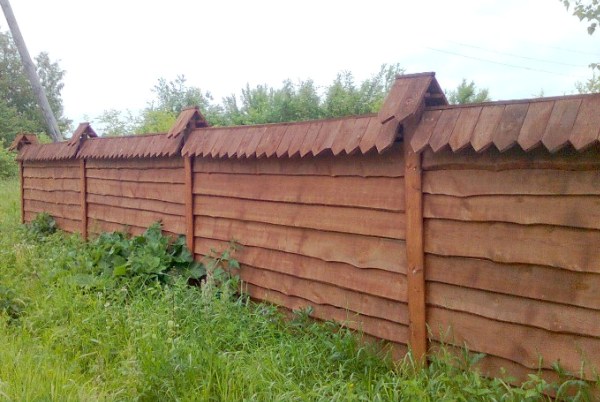
Another interesting option is the "artificial" slab. In this case, the edges of the boards are cut so that they form a symmetrical pattern.
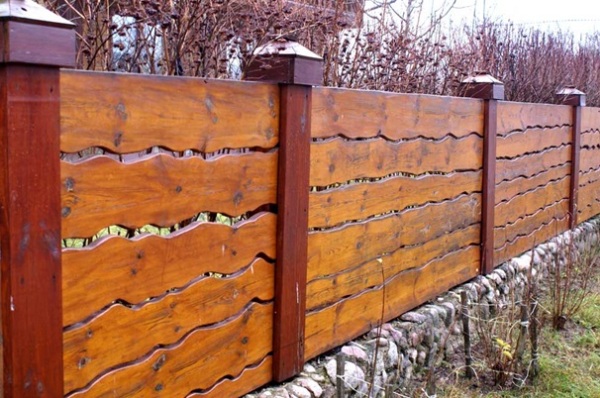
To create a color contrast, the wooden pads on poles are treated with dark stain.
The method of "decorative turning" is equally acceptable for both the slab and the edging board. In the latter case we get an aesthetic fence-shutters. With a direct look, he looks deaf. However, due to the gaps between the slats, this design not only is well ventilated, but also partially transmits the sun's rays.
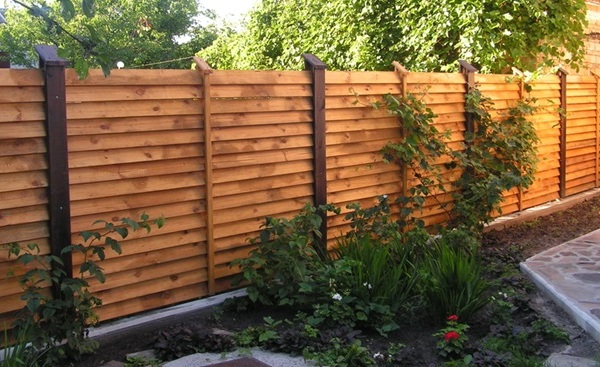
Plaiting plants like these fences and quickly turn them into blossoming trellises.
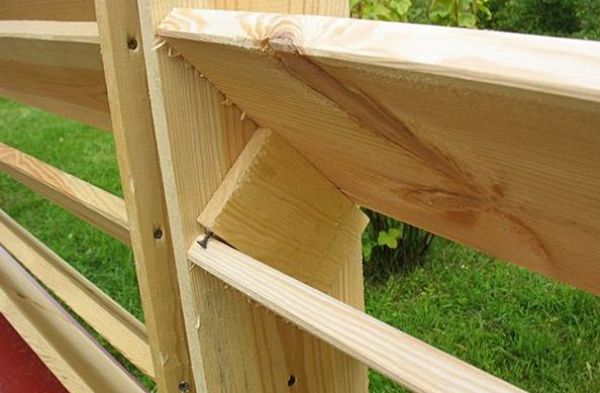
Fragment of the fence-shutters design from the edging board
In passing, we note that the best basis for fixing the fence boards is metal bars. A compromise option is the embedding of steel clips from the profile pipe cuttings in concrete. They put wooden stands and fix them with screws.
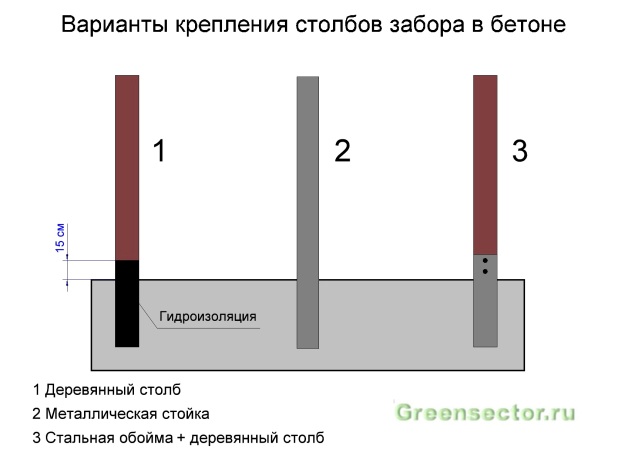
A bit of fantasy and plain-looking gougebel-Obapol turns into a designer fence, guarding the "kingdom of Berendey."
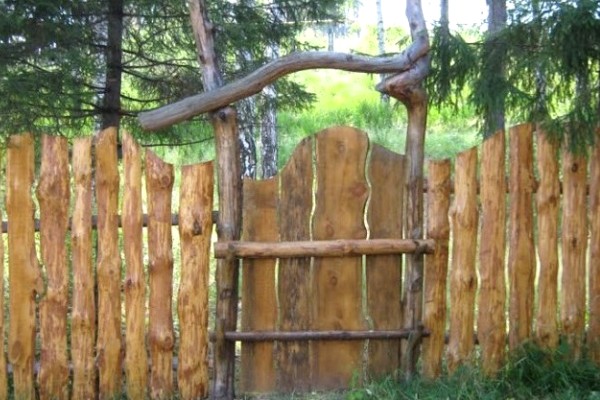
Posts for this fence can be cut from a cheap roundwood-tonkomer. The natural form of this material will perfectly fit into the "country design" chosen for this fence.
A classic fence (planed board with a rounded edge) remains an actual element of the fence structure. The only condition - do not paint it with a dull green or brown paint. Better treat the slats with antiseptic and open a couple of times with a good varnish. Wood after such a debugging will play golden shades and will stand for 10 years longer.
![]()
If you like tinted wood, then use dark brown paint for this purpose. It reliably protects the fence from dampness and gives it a noble appearance.
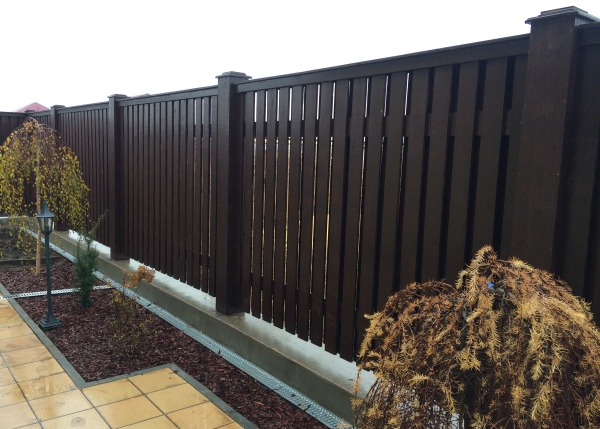
A blind fence from the edging board looks better when the vertical bars are not installed on one side, but on both sides overlap. This installation scheme creates a rhythmic stepped structure. The ends of the boards are covered from above with a planed bar. Decorative frame bezel mount and the bottom of the fence.
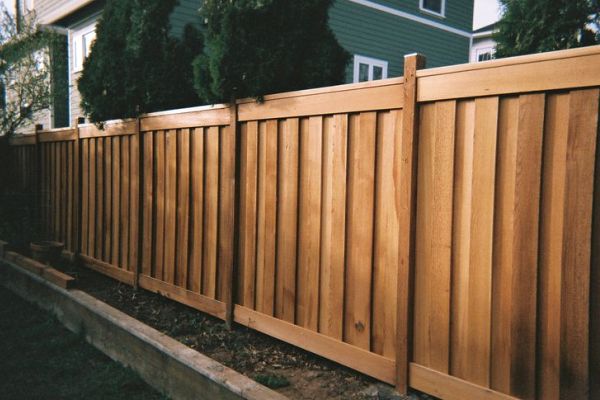
A dull fence will not look boring if its arched circuit incorporates arched lattices from a thin bar.
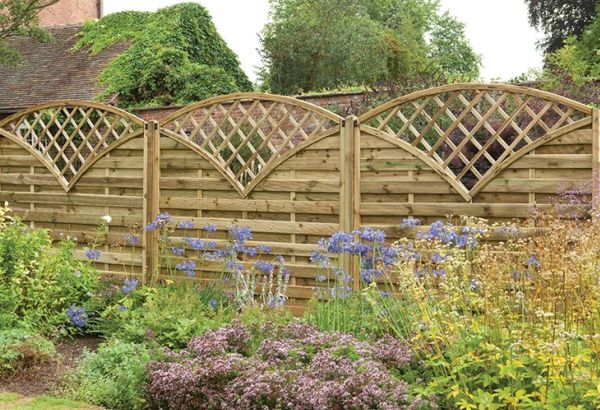
Arched lattice inserts eliminate the monotony of a blind fence
Choosing the material for the fence, pay attention to the terrace board. It is strong, expressive and durable. Fasten it to the metal posts installed in the concrete foundation.
The photo below shows a variant of a two-way horizontal installation of a terrace board (an American fence). To increase the rigidity in the middle part of the spans are vertical bars.
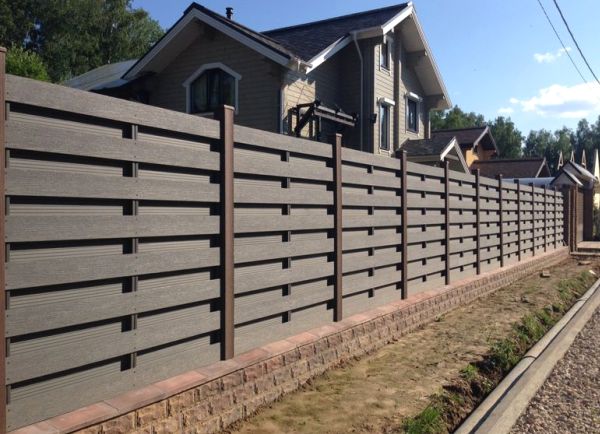
Fence from the terrace board - a guarantee of 50 years
Such a fence can not be called cheap, but it is very durable and beautiful. The terrace board is made of colored wood-polymer composite and does not need painting.
In the fence structure, the board can be combined with a bar. Below we see a version of the fence, in which the bar is installed from the outside, and the board is nailed from the inside. Its joints are not visible, because they are covered by a bar. Brown wood tinting in contrast with the white base gives the structure a solid and sound look.
![]()
From the front this fence is made solid. On the side of the fence at the bottom of the board there. This decision was made to improve the ventilation area.
Far from Russia from America, but the romance of the cowboy ranch reached us. On a spacious site, distant from other buildings, looks fine low fence in the style of country. Its basis is thick wooden pillars, to which, on the one hand, three belts of boards are horizontally nailed. In the upper part, the wooden bar is cross-shaped, closing the open "windows" of the sections.
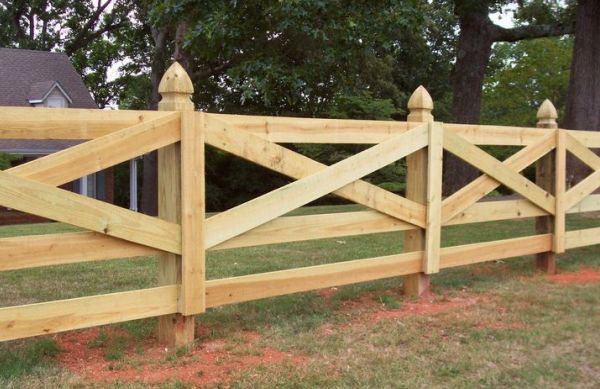
Wicker fences from the board
If someone tells you that you can weave the fences out of the board, do not doubt. Today this is the most fashionable topic. It looks like a wicker fence of boards is great, and there are many options for its installation.
Board for wicker fencing should not be very thick. Therefore, having bought an edged "thirty" in the warehouse, you can safely stretch it from both sides to a thickness of 25 mm. The optimum width of the bar is from 8 to 10 cm.
The simplest version of such a fence resembles the wall of a summer gazebo. Having made from wooden slats openwork panels, they are fastened to posts. On the contour for contrast you can nail the frame from the dark board.
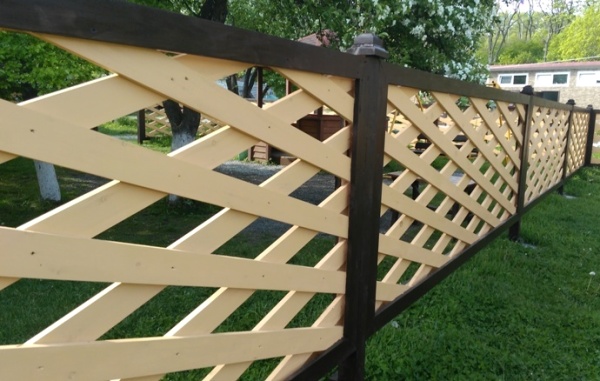
The wooden fence with a pattern "in rhombus" is elegant and light
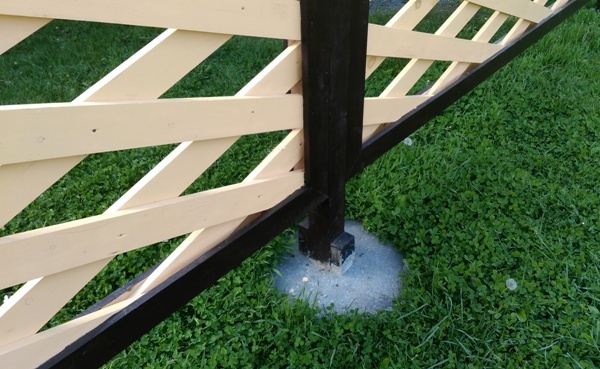
The wooden fence stand is antiseptic and concreted in the ground
And here is another, no less interesting plaited plaque.
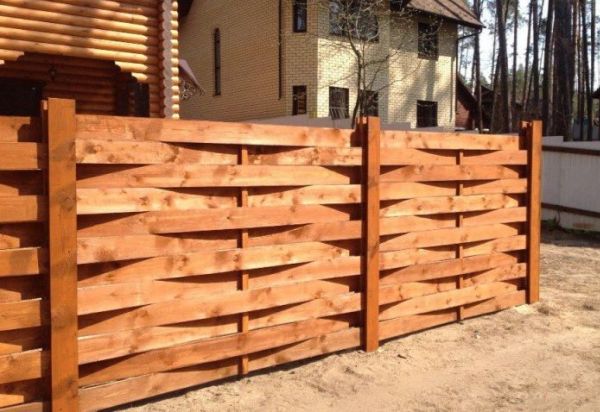
Here, a thin planed board 25 mm thick and 2.5 meters long is staggered to the posts in a checkerboard pattern. The bend is attached to the original method of installation: the ends of the boards are alternately fastened on one and the other side of the wooden post. In the middle part of the span there is a vertical rack, fixing the bend. Places of fastening of boards to racks are covered by planks.
The vertical plaiting from the boards looks no worse. In this case, the answer to the question which board is better to use for the fence is obvious: at a length of 2 meters, the lath is most easily bent, with a thickness of not more than 16 mm and a width of 8 cm.
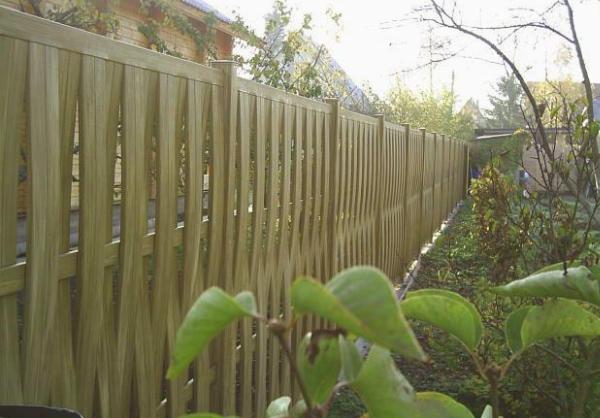
Everyone likes a wicker fence, but it can be improved by combining it with a fence.
This design is quite difficult to install, but its picturesque appearance justifies all the efforts expended.
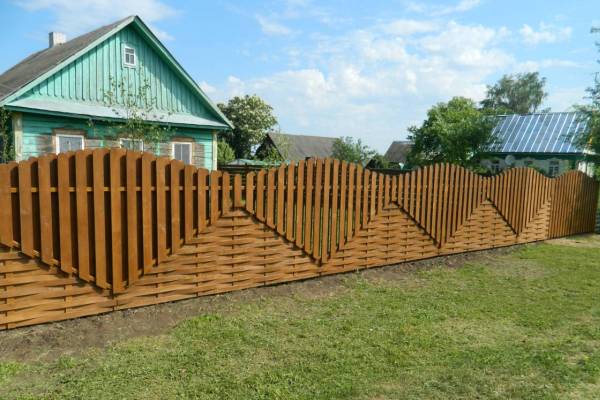
The original version of the fencing, combining plaiting from the boards with a two-way fence installation
Those wishing to build an exclusive fence from the boards should contact the experienced master. Only he will be able to assemble the design captured in this photo.
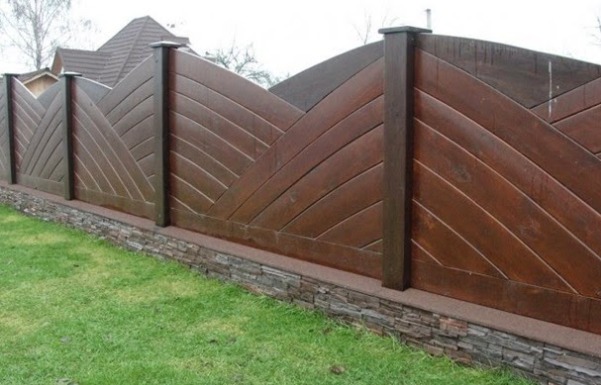
Each board for such a fence is cut out separately, based on the section template. At its ends and side faces, the connecting spikes are cut, by which boards are paired together according to the principle of puzzles, fastened to posts and to the lower belt.
The advice that we gave on the course of the article should be supplemented with the parameters of the main elements of the board fence:
- The size of the cross-section of wooden poles is 10х10 cm.
- In the case of use for steel profile racks, its cross-section must be not less than 40x40 mm (wall 2 mm).
- Horizontal bars (runs) should have a section of not less than 30x50 mm with a step of 2 meters.
- For the convenience of mounting wooden girders, the steel racks need to weld the fastening plates "ears" with holes drilled in them for self-tapping screws.
At the stage of purchasing materials, the question arises, how to calculate how many planks are needed for the fence. It is solved simply. If the fence is solid, then its total length should be multiplied by the height and thickness of the board being purchased.
For a lattice fence of a fence, the calculation is done differently. Taking into account the chosen step, the bars determine their number by 1 running meter of the fence. The obtained pieces are multiplied by the total length of the fence, and, if necessary, transferred to cubic meters, multiplying the total area by the thickness of one bar.
Another important point - how to paint the fence of the boards? If you save on the quality of paint, then the fence will have to be updated more often. Therefore, we recommend buying expensive paint for outdoor work. Before applying it, treat the board with hot linseed oil or antiseptic impregnation. The consumption of paint and impregnation will be minimal when applied to a planed board. Take note of this nuance when choosing a material.
Given the large area of the board fence, you need to paint it with a roller or spray gun. Passes and flaws committed during work are corrected by the paint brush.
The farm will benefit from everything, including residues after using wood. Slab, or unedged board - is the most optimal material for making a fence. The main difference of this material is that its edges are not sawed off or partially cut off. But at the same time it is possible to use such boards as a roofing or covering of roofs, load-bearing structures, decking and so on, that is, where there are no special requirements to the aesthetics of appearance.
How to choose lumber?
Before making a fence of boards with your own hands, you need to choose it competently. Before buying this building material, you need to pay attention to some points. First of all, there should be no knots on the boards, as they not only disturb the structure of the wood and spoil its appearance, but also affect the longevity of the material. Unedged board is obtained from softwood, and its quality can be assessed by several parameters:
- The surface of the material should be free from potholes, cracks, chips.
- Choose a croaker with no knots.
- The cross section must be of the correct shape.
How to make a fence?
Choosing the material to create a fence for suburban areas, many use stone or corrugated board, but the most economically viable solution will be the use of wood. The fence from the unedged board can be pocketed for each owner of the site, while from this material it is possible to create a very original fence. We have already mentioned the main parameters for selecting this material. By the way, before proceeding with the installation of the fence, the material must necessarily be treated with protective antiseptics - this will not only make the fence surface brighter and more beautiful, but also help protect against the effects of negative phenomena.
We prepare materials
To make a fence, we need to purchase an unedged board and deliver it to the object. In addition to the boards, you will need to stock up with a number of other materials, namely a profile pipe that will serve as support pillars: its cross section should be 40x60, and the length - not less than three meters. To calculate the number of metal blanks, you need to take into account the length of the future fence and the area of the site. Before you start making a fence of boards with your own hands, you should perform all measurements and plan the territory.
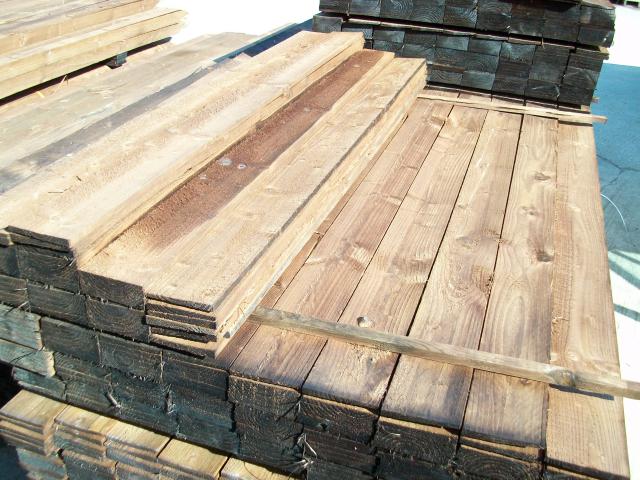
Support pillars need to be dug into the ground, and for compaction, a preparatory cushion based on gravel and sand is required. Depth of submergence of the pillars should be calculated depending on what are the features of soil behavior in winter, but the average depth of digging is 0,8-1,2 m. Between the supports it is necessary to leave a distance of approximately 2.5 m. The fastening of the poles is carried out with the help of concrete solution, while the profiles themselves can be coated with a compound that protects them from corrosion. To the dug-in pillars should be attached horizontal lags, to which the boards will be fastened. Their location depends solely on the wishes of each individual site owner. The main feature of the unedged board is that it is possible to make a fence of a certain type, especially if you supplement the landscape design with the help of tracks from the saws of a tree.
What is a good fence of sawn timber?
The cost of fence is the determining factor explaining the popularity of this material among buyers. At the same time, each design can be given an interesting look, for example, by using an image on it of a painting or some other design move. The second advantage of this fence is the simplicity of installation, which can be performed independently. The only drawback, which is quite significant, is the need for additional processing, since the tree must be impregnated with antiseptics and periodically renew the paintwork.
Fence with foundation
Unedged board, despite the fact that it appears as waste in the process of board production, is an environmentally friendly material with which you can create decorative fences, build walls in barns and create a crate. In this case, the installation of the fence by its technology can not be inferior to the construction of the house. And because responsible owners even a fence create on the foundation, so that it is reliable, strong and durable. It is easy to trace the analogy of these two construction processes:
- When building houses and fences, a strip foundation is used.
- In both cases, the boards can be overlapped.
- Board, as a building material, requires special care, namely impregnation. From what it is necessary to protect the fence - water, sun, snow, bark beetles and rodents. And this applies to both wooden fences and wooden walls.
- Both processes - both erection of a cottage, and installation of a fence - can be carried out independently.
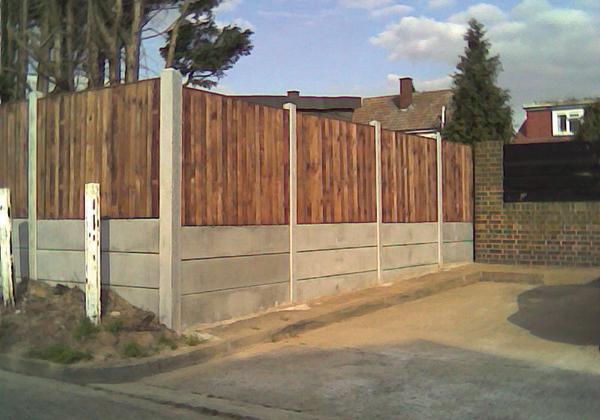
In any case, the board requires special impregnation from atmospheric influences, as well as bark beetles and decay. The top edge of the fence, like the walls of the house, it is desirable to cover the roof or a canopy. And most importantly - and the walls of the house, and fences made of unedged boards can be easily built with their own hands, but how, our instructions will tell.
Phase one: foundation pouring
Of course, not everyone does a fence of unedged boards on the basis of the foundation, but if the fence is massive enough, then without strengthening the base is indispensable. To create a fence enough nest dotted or stationary ribbon foundation. The first method is the most common and economical. The fill will be performed in several stages:
- First, marking is done: for this, pegs are driven into the corners of the site, which are connected with a rope. So we will create a marking line.
- Every two or three meters we prepare holes. The pitch depends on the number and length of boards that will be used to create the fence. The well must be of sufficient depth.
- We put the channels in the finished holes.
- We pour in the holes a mixture of crushed stone, sand and cement. Add the water until you get a gruel.
- Align the columns and leave until the concrete hardens.
Raise the fence
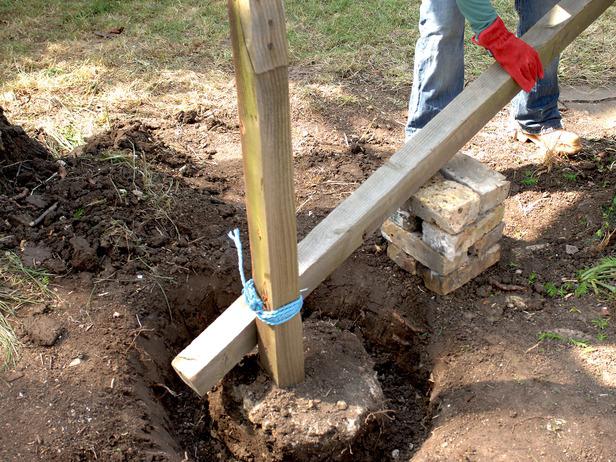
Fences for giving can be done in several ways. Unedged board can be mounted horizontally, vertically or overlapping. The easiest way is to lay the boards horizontally: we fill the beams with boards or fix them with screws. Since the material has untreated edges to remove slots, you can close them on the inside with the same boards. The vertical fence has a more complex construction: on the transverse boards from above and below it is necessary to stuff the material.
Protection from pests - at the core of the basics
Any fence from the boards must necessarily be processed, because any natural material is exposed to a wide variety of influences. Provide protection in several ways: paint, varnish or antiseptic composition. However, ideally, these works should be carried out in advance. First, the boards need to be cleaned of the bark, sanded and soaked with antiseptic agents or primers - this will protect the surface from biological factors. At the second stage, we finish the finish, for example, varnish with stain or special paint for wood.
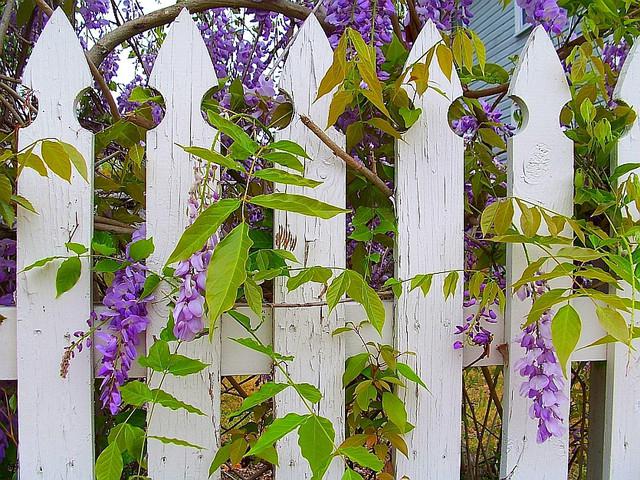
To ensure that the fence of the unedged board had an aesthetic appearance and at the same time lasted longer, a number of activities can be performed. For example, to prevent moisture from accumulating on the fence, you can cover it with an improvised canopy. In addition, the fence can be given a decorative appearance, for example, decorating its flower pots with flowers or painting it in interesting compositions.
Unedged board alternative
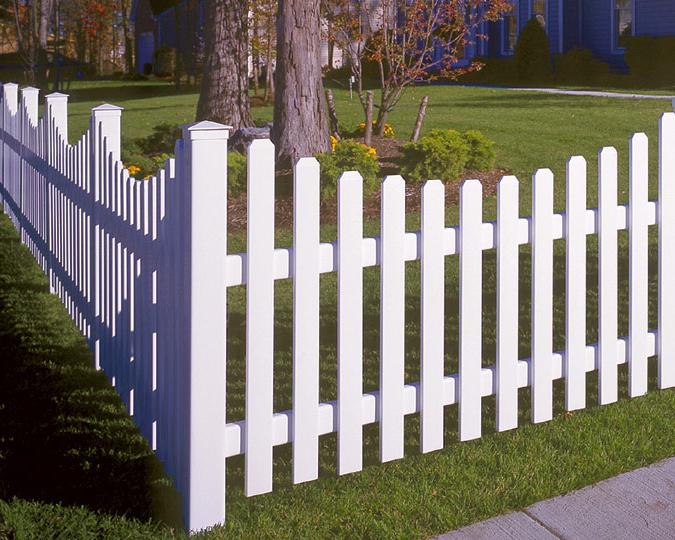
Many refuse to build a traditional wooden fence, which is replaced gradually by a fence-fence. Thanks to this material, the fence is perfectly even and attractive. At the same time, the fence can be any height, shape, color, making the suburban area original and stylish. The distinctive features of the fence fence include:
- universality - wooden fences harmoniously fit into the landscape, perfectly combined with brick, stone, concrete, metal;
- simplicity of installation - installation of a fence can be carried out and independently without participation of experts;
- convenience of care, which consists only in the timely staining and elimination of defects that may occur from time to time;
- reliability;
- the possibility of landing next to the fencing of flower beds.
Preparing the material
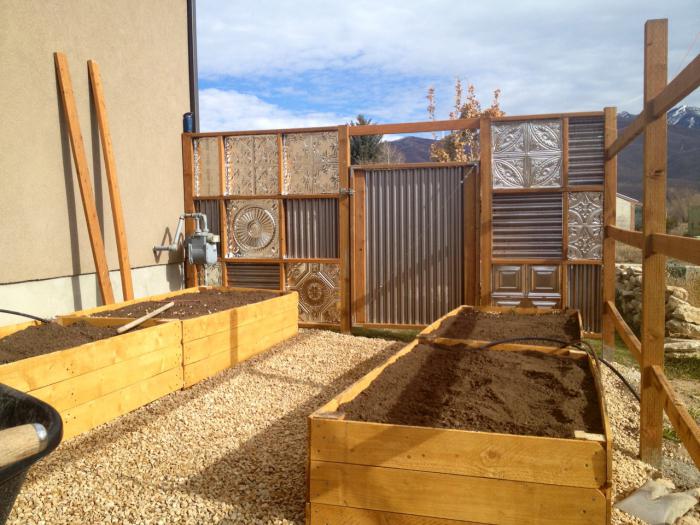
First, we will need pillars made of metal pipes or massive bars. Secondly, directly the scaffolds are narrow racks, which are created from planed boards. Thirdly, veins will be placed between the pillars: we need materials with a length of up to 2.5 m and a section of 40 mm. To make a fence fence of boards, the material can be made by yourself or bought already ready. In the first case, you have to work hard, and in the second case you can perform the installation on the same day. The only danger - a fence can be created from poor-quality raw materials, because of what the fence design can be skewed. If the material needs drying, you need to use special dryers for the wood.
Installation and assembly
To make a gate, fences from a fence, you need to adhere to a certain technology.
- Define the direction of the fence.
- We release the site under the fence from debris, weeds.
- We designate beacons and use the thread to determine the places under the poles.
- Between the poles we leave a distance of about three meters, otherwise the spans between the supports can lead to sagging under the weight of the pins.
- We install support pillars in the ground, if we need to strengthen the structure - we use a cement-sand mortar.
- For the installation of columns it is necessary to dig a pit approximately 1.3 meters deep. Using gravel cushions, we prevent the extrusion of the support when the soil freezes.
- After the installation of the posts, it is possible to erect the streaks, which are fastened between the poles, and the boards are fixed to them.
- First we attach the bracket vertically, and the others are aligned relatively to it along the T-shaped template.
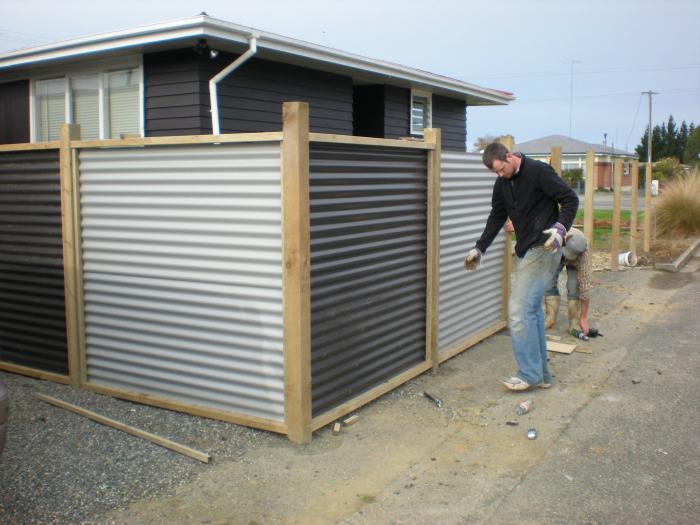
That fences for a summer residence were beautiful, it is possible to use various ways of decoration. Mandatory processing, for example, using stain, lacquer or paint. In order for the compounds to adhere well to the surface of the boards, you must first clean them with sandpaper. Stain will protect the wood from microorganisms and mold, and varnish - from moisture.
Variants of fences for cottages
Despite the fact that the wooden structures are now popular again, it is not necessary to erect a fence of unedged boards around their site. There are many other options. For example, it is very popular for the installation of a fence euro trolley, which is made of galvanized steel and covered with a polymer composition. This material is characterized by strength, reliability, durability, ease of installation and unpretentious care. Establishing such a fence, you can not be afraid that it will create the impression of a closed space, where no light will go. Due to the wide color palette, it is possible to create a harmonious landscape design.
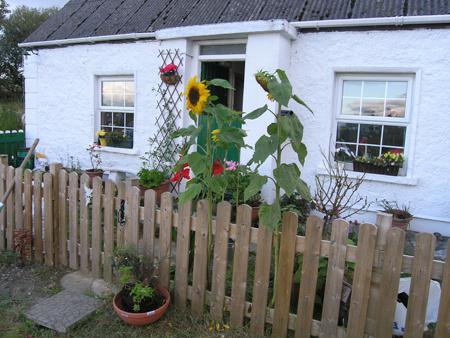
To make such fences, poles are required in the form of shaped pipes with a section of 60x60. Posts are hammered into the ground to a depth of 1.2 m, concrete, if the soil is loose. After that, 40x20 transverse profile pipes are welded to them, and welded seams are treated with a primer and paint, suitable for the color of a metal fence. We mount the gate and gate, picking up the necessary hardware for them. To prevent water from accumulating in the pipes, plastic plugs can be mounted to the end of the poles. Euro-tackle is fastened to the carcass with self-tapping screws, while the gap between the pickets is kept very small - 2-4 cm. To give the fence aesthetic appearance, you can decorate it with a ridge strap.
Variety of fencing types
Many owners choose an economical fence from an unedged board. The photo shows that even from such material it is possible to create interesting. Any fence from a tree looks stylish and natural, while it can be made from a fence or unedged board, in a rustic style in the form of a fence or in the spirit of an American ranch.
Metal fencing is also popular because they are more reliable and durable. But on the other hand, they also need additional processing from corrosion and moisture. The most economical and easiest in terms of erection is the grid of Rabitsa. It can simply be pulled on metal poles or a frame, or you can create separate sections. More complex will be the construction of a corrugated mesh, which is an interlacing of curved wires. Such mesh fences are harmoniously decorated with the help of weaving plants. will be distinguished by a long service life, increased strength, fire resistance, aesthetic appearance and ease of erection.
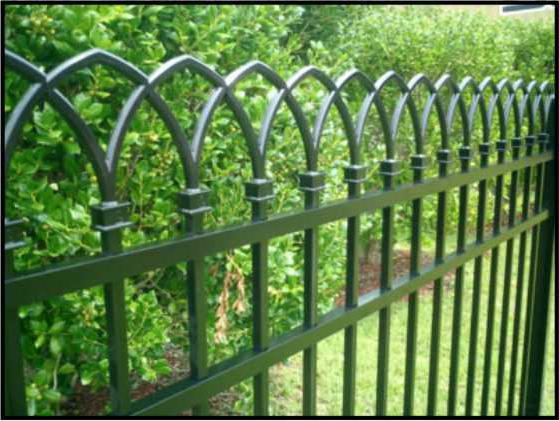
More expensive in terms of costs for materials will be a fence of corrugated board. Ideally, a material having a thickness of about 0.5 mm should be used. Such a flooring will not be covered with dents and will not lose its attractiveness. It is best to use a corrugated board with a two-sided polymer coating - this will prevent stains and corrosion. If you compare the price, the most advantageous solution will be the erection of a fence of metal mesh.
The fence is made of plastic. Due to the fact that modern technologies are constantly evolving and improving, even this material has become more reliable, efficient and quality. To establish such a fence is simple, while the structure of the fence will be strong and resistant to the formation of cracks. Such a fence will be resistant to sunlight, temperature changes, high humidity.
Fundamental rules
The fence can be made independently, and from any material. A number of rules should be taken into account:
- Bearing construction must be carried out taking into account the weight of the fence.
- At the base of any fence there should be pillars, which reliably and densely deepen and are fixed in the ground.
- On the basis of what material the fence will be built, the pitch of the supports depends.
- Before you perform its installation, you must first familiarize yourself with the technology of work.
Self-assembly is very convenient and profitable, since you can control the consumption of resources and save them.
What is a fence, that is, what functions does it perform? The first is the enclosing element, the second is protection from the curious eyes, the third is the border that defines your territory.
Talking about the great variety of materials from which you can build a fence, there is no point. In this article, the conversation will be about one of them - this is a fence board.
This material has been used as a fencing since time immemorial. And if we speak frankly, we can say that the fence from the board is a purely Russian product. And, as practice shows, it still has not lost its relevance today.
Do you know why?
- At first, boards for a fence is for today the most accessible material.
- Secondly, the natural beauty of the tree has not been canceled yet. And it does not matter from what material your country house was erected, the fences from the board will adorn it no less than, say, or metal. And if the house was built of logs or timber, the wooden fence is something that you just need. The combination will be magnificent.
- Thirdly, the price today is not so high that it would be possible to look for an alternative to it. By the way, the cost is determined by the methods of processing.
Requirements for fence boards
And yet this material will be placed on the street, so to speak, in negative conditions, where snow, rain, sun and wind make their fatal case. Add a large number of insects that feed on wood. Therefore, choosing it, it is necessary to pay special attention to quality.
Types of fence board
Currently, the modern market of building materials offers two main types: edged board for fence and unedged. What is their difference from each other? In the degree of processing.
Cutting material
Produce it mainly from coniferous species of wood, with the removal of the veneer (this is the bark of the tree that remains on its sides). This is a quality material that meets the GOSTs used in the woodworking industry. That is, with a certain humidity, and the higher the humidity, the lower the cost.
This type of sawn timber is used in many construction processes, where it is necessary to note: flooring, construction of fences, erection of frames and partitions. As one of the subspecies is a planed board, which has the highest quality index.
Adjusted geometric shapes, optimal humidity, high grade (the least number of defects), the cost is slightly higher than the usually edging type.
Unedged timber
These boards do not saw off the edges (partially sawed). That is, the bark of the tree always remains on its sides.
Accordingly, and their price is much lower, which often attracts developers. But you can not use it anywhere.
Unedged view
Where exactly:
- Construction of temporary enclosing elements (fences for construction sites);
- Construction of formwork for concrete structures;
- Construction of forests;
- Used in the roughing of premises;
- As a black ceiling and attic flooring.
That is, the demand for this material is in those places where the appearance does not matter. I would like to draw attention to two factors that relate to the survey. It can be blunt - that is, cover the entire edge, or sharp - covers it partially.
Attention! A cut at the edge does not in any way degrade the quality characteristics of the material itself. Keep this in mind. So do not be afraid to load it.
And one more thing that concerns quality. Cut logs from the core of a log unedged boards have higher quality indicators.
That is, fewer defects (knots, cracks), more density. The closer to the croaker, the worse the performance.
How to build a fence yourself
This is a fairly simple process that you can do by yourself. For this, in addition to the boards, you will need a beam for the vertical racks to which they will be attached, as well as horizontal rails. First of all, it is recommended to determine which fence from the edging board you want to see on your own site.
There are two main types:
- Boarded fence.
The first is a fence where there is space left between the boards. The second - without gaps. But in any case, the instruction (technology) of erection is the same.
Racks must be installed (buried) in the ground, and the deeper, the better (consider the wind loads and the freezing level of the ground). There is an important point here - the waterproofing of a piece of timber that remains under the ground, which affects the durability of the entire structure. The distance between the posts is not more than two meters.
Now to them from the outside, that is, from the street, two horizontal rows of rails are attached. Remember that the optimal distance from the ground and from the top edge of the fence to the laths should not be less than 20 centimeters.
If the height of the fence exceeds two meters, then you will have to install three or four rows of rails. Fastening between elements can be carried out with nails or self-tapping screws.
Now it only remains to fill the boards. The main thing is to install them vertically precisely, use the building level for this.
Conclusion on the topic
On this page of the site there are videos and photos that show all the varieties of timber sampling material. And still, if your home is the place you are proud of and which confirms the postulate: "my house is my fortress", we recommend using such material as a planed board.
How to put a fence of edged boards with your own hands
Edged board is a kind of material that is currently widely used in construction. It is used in a variety of types of construction work, ranging from finishing rooms, making furniture and finishing with the construction of fences.
About what are its characteristics, advantages and disadvantages and how to make a fence out of it - and we will discuss this article.
Characteristics of the material
 Produce it in accordance with GOSTs mainly from coniferous trees, for example, from pine, larch, spruce. This is due to the lower cost of coniferous species compared to oak or ash wood. Boards made from oak or birch are also made, but they are somewhat more expensive, they are distinguished by higher strength, but they deteriorate more quickly in wet conditions.
Produce it in accordance with GOSTs mainly from coniferous trees, for example, from pine, larch, spruce. This is due to the lower cost of coniferous species compared to oak or ash wood. Boards made from oak or birch are also made, but they are somewhat more expensive, they are distinguished by higher strength, but they deteriorate more quickly in wet conditions.
In contrast to the unedged board, the width of which is equal to the width of the tree from which it was made, the edged cortex is removed from the sides. On a unedged board you can find knots, irregularities, roughness of wood, while edging - ready-made building material, which does not require any additional processing.
The average width of one unit of this building material is about one meter, while its length can vary from 2-3 to 10 meters.
Advantages and disadvantages
Allocate the following advantages:
- The main advantage of this finishing material is a relatively low price, which is about 6-10 thousand rubles per cubic meter, depending on the grade, length, width of the board and its section. This explains its wide use in construction.
- The edged board is distinguished by its strength and durability and at the same time simplicity of installation, that is, the process of erecting a fence from this building material does not require special knowledge and skills.
- Keep the board for a long time, the only nuance - it is better to choose a dry room, because at high humidity the tree has a property to deteriorate and rot.
- Another distinctive feature of the lumber is the simplicity of storage and transportation.
- The fence from it looks beautiful and aesthetic compared to. On the surface of the fence there are no knots and irregularities, it has a noble appearance. In addition to the beautiful appearance, the structure is longevous with proper conditions of erection and processing.
- With the help of the edging board it is possible to build a fence of the most different appearance and configuration, it can be both a decorative option and an ordinary classic summer fence.
- When building a fence there is no need for preliminary preparation of the foundation, the boards are attached directly to the metal screeds.
The disadvantages can be attributed to the fact that, like any tree, the edging board, not processed from above with special protective equipment, can begin to deteriorate, rot. After all, daily on such a fencing will affect the aggressive factors of the external environment, such as rain, wind, and in the summer and hot sun.
In addition, many insects eat wood. To avoid damage to the structure, the fence on top should be treated with paint or special protective equipment, which will protect it from premature deterioration and decay.
The fence is less durable than brick, in addition, it requires regular maintenance, in some places it may need to be repainted or repaired.
Construction process
Before proceeding with the erection of the fence, it is necessary to determine the material and its quantity, which may be needed during construction. The calculation of the number of boards depends on how tightly the fence strips fit each other and whether they are two-sided or one-sided. If it is planned to create a bilateral version, then the number of purchased boards should be increased by 2 times.
The most common way of erecting a wooden fence - on metal bars. To do this, you will need to additionally purchase a metal profile, which you will then need to cut yourself into slats with a Bulgarian or ask to do it in the company where the building material is purchased. Cut the profile follows from the calculation that its height will be equal to the height of the future fence plus 80 cm. This is the height to which it will enter the ground.
- The first stage of construction is the drilling of one-meter-deep depressions. You can do it yourself using a shovel.
- Building debris such as gravel, sand, scrap is laid on the bottom of each pit.
- Then a metal strip is placed in the center of the hole and filled with concrete.
- After the metal frame of the fence is erected, you should go directly to the fastening of the edging board. It is fixed to the base with bolts that are inserted into pre-drilled holes.
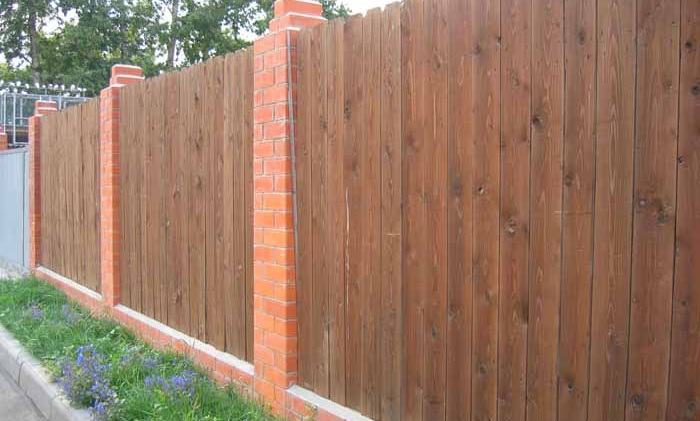
You can build a fence and based on brick or stone supports, but in any case, the first layer of planks should be protected from the ground not less than 10 centimeters, otherwise they can start to deteriorate and rot. In addition, you can mount boards not only on vertical, but also on horizontal supports.
On the following video, you can see the process of erecting such hedges:
Than to paint a fencing
Wooden fencing can be treated with paint, varnish or a special antiseptic solution. But the most common procedure is its painting.
If before used for painting used oil paint, the modern market offers a wider choice of coloring compounds. There are ukryvochnye paint, which completely hide the original color and structure of the board. Opposite to her species are scaffold compositions, which, on the contrary, do not conceal the color and structure of the wood. Use also acrylic options or a transparent construction glaze.
- First you need to grind the fence with sandpaper or grinding machine, this procedure will eliminate irregularities on the surface of the board, which will further apply the paint in an even layer.
- If the wooden material suddenly turned out to be potholes or cracks, then they should be primed and puttyed. After this, you should wait until the putty dries, and only after that, start painting.
- Then you can apply the paint. Do it better in dry, windless weather. Painting the fence should be top-down, preferably with a wide brush.
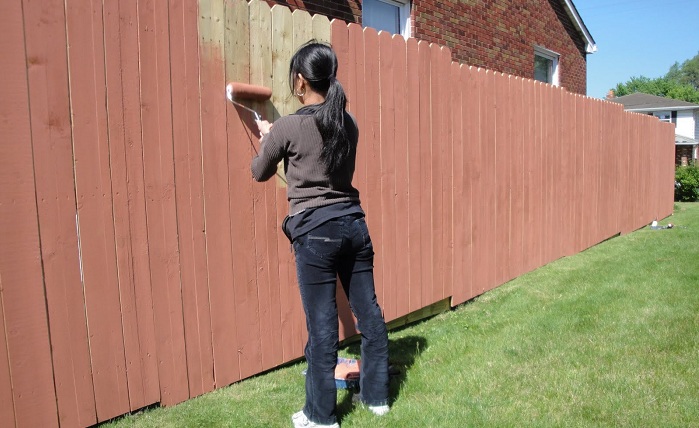
Painting the fence allows it to give a beautiful appearance and hide various board defects, such as uneven texture or a non-uniform color.
Varnish fences are rare enough, and then only in those cases, if you want to emphasize the beautiful structure of the tree.
Some masters of country houses and suburban areas do not paint a fence, but only apply antiseptics on it, which are also very different: compositions from mold or from decay, from harmful microorganisms. Apply them with a brush or a special roller. It is better to paint the fence after this, it will ensure the preservation of wood for a longer period.
Photo gallery of fencing from edging board
The photo shows different types of fences from this material:
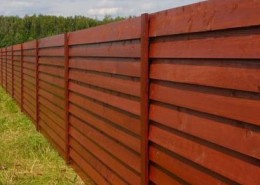
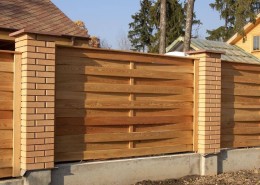
![]()
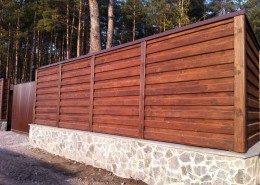
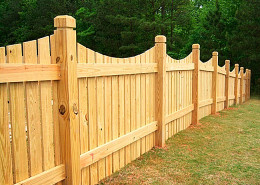
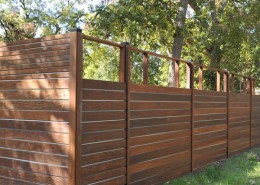
In comparison with a concrete fence or a grid-rabitsa it is distinguished:
Availability on any sawmill and as a consequence - the cost,
Durability (with proper treatment with antiseptic), in contrast to the grid, which in a couple of years will eat rust,
Ease of installation,
Ecological, natural and harmonious with the country landscape.
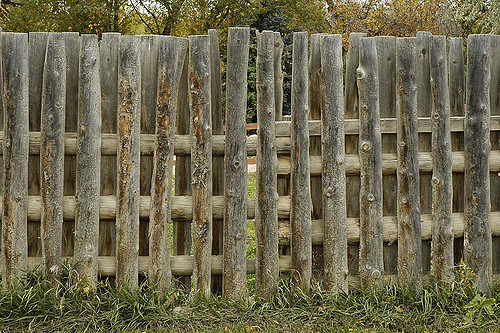
Gorbyl in its properties is not inferior to boards and other wood, its only negative is its appearance. In this article we will tell you how to turn it into a plus
With the help of decor, even such a simple structure can become a real masterpiece.
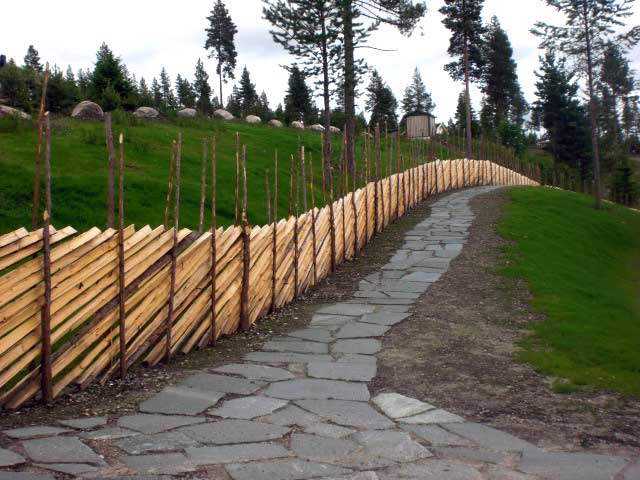
How to make a fence from the slab with your own hands
1. Look through the croaker, sort. It is desirable that the plates should be placed at a height of 20-25 cm.
2. Remove the bark from the selected plates. If a bark beetle settles in a tree, it will easily destroy it in a couple of years. The bark can be removed with a sharp shovel, ax or cramp.
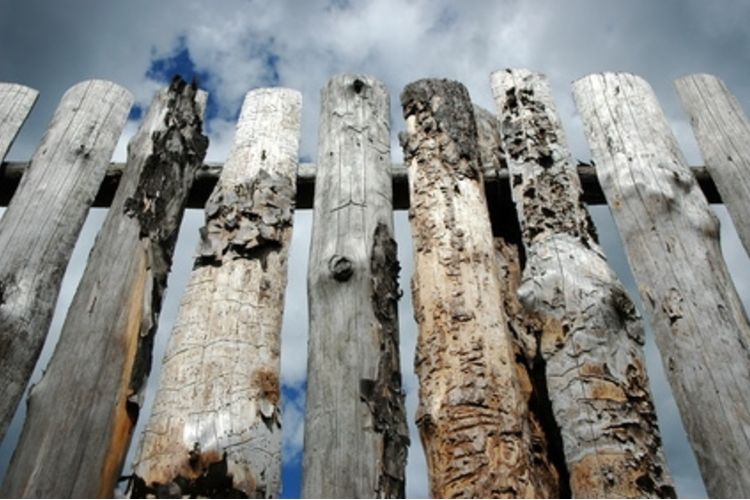
4. The next stage (even more responsible) is the preparation of the pillars of the future fence.
As metal poles, you can take pipes 70-80 mm in diameter (with a wall thickness of more than 3 mm).
![]()
But such a fence will be more difficult to make because of the heterogeneous material. The pipes still need to weld plates, on which the wooden beams will be fixed horizontally, and cover them with a protective mastic against corrosion.
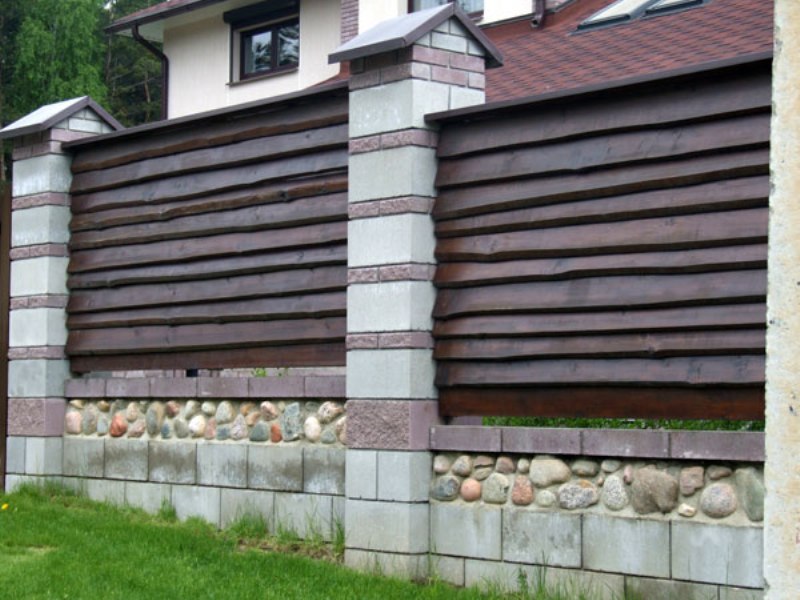
Wooden poles (oak, larch, pine) are also perfect for your needs. The diameter of the stem of the pillars should be at least 20 cm, and the length - the height of the fence + 60 cm.
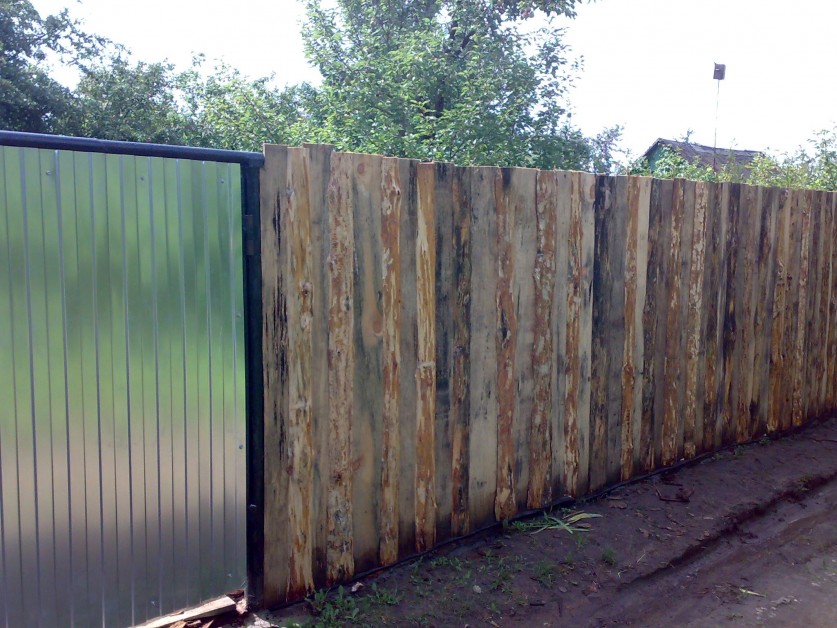
Remove the bark, burn the pillar, cover with protective means - water-repellent, from mold, hot resin, varnish or varnish - this will save the part of the pillar located in the ground from decay.
It is possible to use roofing material - this will improve waterproofing properties.
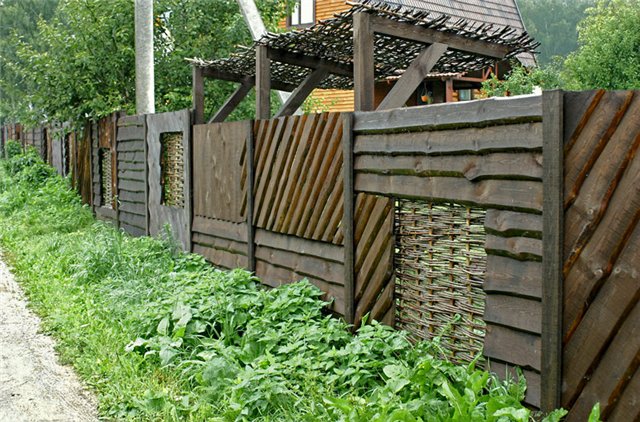
Digging the pillars.
It all depends on what soil the fence will stand on. If it is a loam, the poles can be clogged directly into the ground in pre-drilled with a bit bore.
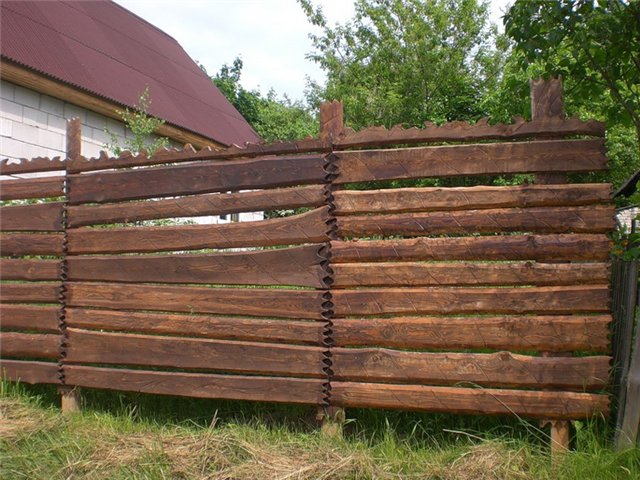
Borrow from a fisherman's familiar fisherman and make a 50-60 cm hole. Further, with a sledgehammer you drive a pole into the ground, putting a flat board on the end.
If sand or chernozem predominates in the summer-resort area, a pit of 60 cm depth and a width of 2 times the diameter of the column is digged under each pillar. Place the bottom of the pit with a sand cushion 10-20 cm high (gravel / gravel + sand).
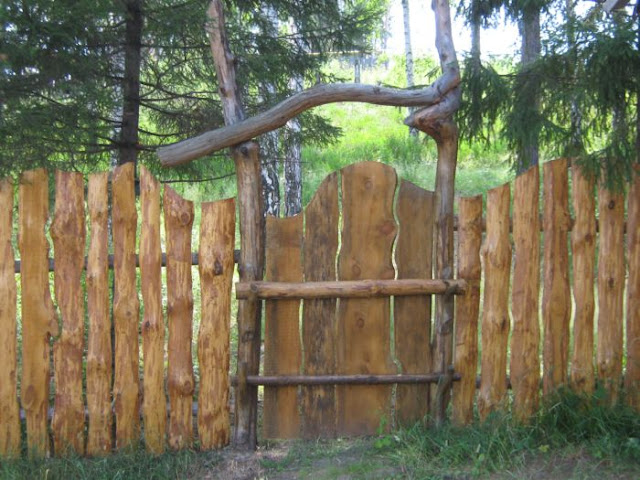
Everyone tamper and make a spill. Fix the installed column with gravel on the perimeter, pound it. After that, fill with cement mortar. The next stage can be started in a couple of days - after full hardening.
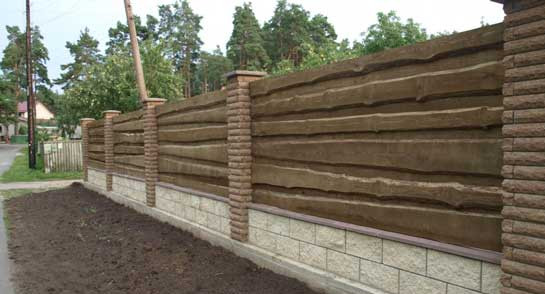
As in the fairy tale "High Tesovy Gates"
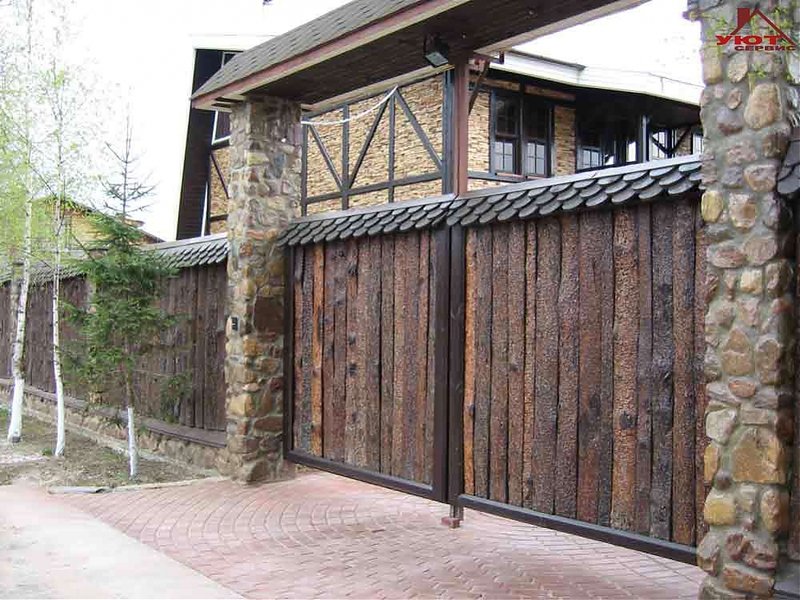
6. Mounting the slab.
You can nail it horizontally or vertically. It all depends on your taste preferences. Because the material is not uniform, you can install it, either leaving gaps, or fixing the overlap, creating a solid wall.
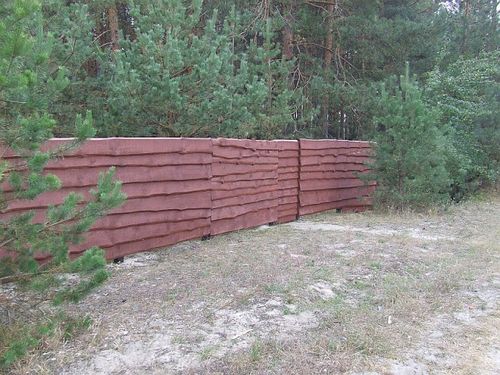
To cut the croaker horizontally, a bar is fixed to the support posts along the entire length, then a slab is attached to it by means of screws or nails. It is preferable to use for this nails 150, oiled with linseed oil. Fit to butt hard, make a lap at least 2 cm, the tree will shrink and lose its dimensions.
Vertical skin is executed in a different way. First you need to mount the lags on which it will be attached.
![]()
You can use the slab, it is sawn along and fixed to the girders with the convex side inward. Between the pins the cracks are left in 4-5 cm, then they are closed with the rest of the croaker, fixing it with the convex side outwards.
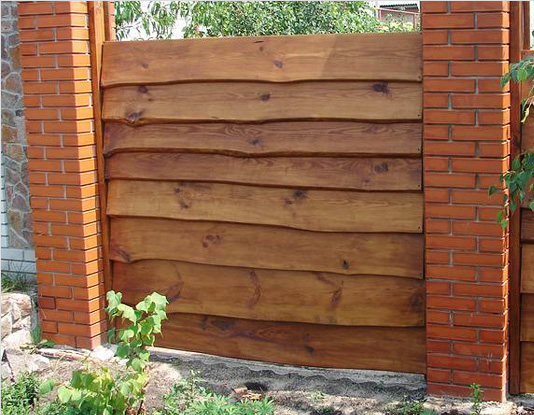
Look at the photo of the ready fences from the slab and the unedged board
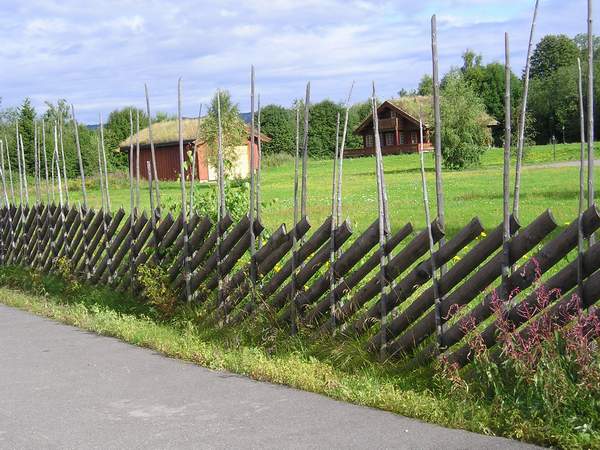 Improve the appearance of such a "modest" fence easily - paint it. You can not mask the material, but on the contrary, emphasize its natural texture - for this you can cover the fence with varnish for outdoor work
Improve the appearance of such a "modest" fence easily - paint it. You can not mask the material, but on the contrary, emphasize its natural texture - for this you can cover the fence with varnish for outdoor work
